May 2010
Sleep Whale
Sleep Whale
The Parish
Austin, Texas
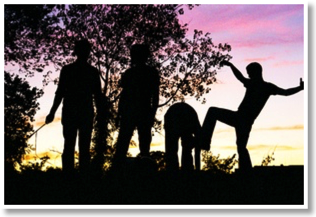 Houseboat, the debut full-length from Denton’s Sleep Whale, is a kaleidoscopic dreamscape of found sound and texture. The moaning cello, plucky acoustic guitar, field recordings and driving drums undulate, with one element never overpowering the others to create the ethereal, calming effect of waves lapping at a shore or the cozy patchwork of a quilt. The stately setting of the Parish – baroque wallpaper, chandeliers and candle scones with fake flames – may have been an odd pairing for the experimental band with arrangements that are more natural than feigned. But, when the bathroom stalls only have the words “Love, love, love, love” etched on them, it’s not as incongruous as it initially seems as the music mimics the listless abandon on, well, a houseboat.
Houseboat, the debut full-length from Denton’s Sleep Whale, is a kaleidoscopic dreamscape of found sound and texture. The moaning cello, plucky acoustic guitar, field recordings and driving drums undulate, with one element never overpowering the others to create the ethereal, calming effect of waves lapping at a shore or the cozy patchwork of a quilt. The stately setting of the Parish – baroque wallpaper, chandeliers and candle scones with fake flames – may have been an odd pairing for the experimental band with arrangements that are more natural than feigned. But, when the bathroom stalls only have the words “Love, love, love, love” etched on them, it’s not as incongruous as it initially seems as the music mimics the listless abandon on, well, a houseboat.
The band, expanded to a quartet from the original duo, was able to translate the buoyant flow of their debut to the live setting. The sounds of water moving, bubbling and dripping dressed the arrangements and acted as transitions in-between the songs. The instrumentals were such seamless testaments to atmosphere that when the vocal tracks arrived, it was almost unnecessary. But instead of demanding attention to the words, the vocals were hazily obscured with reverb, becoming another piece of fabric of the quilt. “Cotton Curls” coasted with shimmering acoustic guitar, flirting electronics, distant “oohs” and cymbal crashes that conjured splashes.
The psych-folk-pop charm of set closer “We Were Dripping” was a cinematic treat. Bubbles popped in time. The light tapping of the cymbals sounded like rain falling on them. The guitar work anchored the track with its idyllic presence. “La-la’s” and a wistful violin made the song as personal as a diary entry: “There’s magic in everything. And we were wet and we were dripping.” The unassuming fog machine spurted out smoke amidst red and blue lights that flooded the stage and revolved around like a lighthouse. Once the song faded, the 4/4 bump of club music could be felt underneath, effectively ending the fanciful experience for a small, but dedicated crowd.
by Joshua Barajas
The Parish
Austin, Texas

The band, expanded to a quartet from the original duo, was able to translate the buoyant flow of their debut to the live setting. The sounds of water moving, bubbling and dripping dressed the arrangements and acted as transitions in-between the songs. The instrumentals were such seamless testaments to atmosphere that when the vocal tracks arrived, it was almost unnecessary. But instead of demanding attention to the words, the vocals were hazily obscured with reverb, becoming another piece of fabric of the quilt. “Cotton Curls” coasted with shimmering acoustic guitar, flirting electronics, distant “oohs” and cymbal crashes that conjured splashes.
The psych-folk-pop charm of set closer “We Were Dripping” was a cinematic treat. Bubbles popped in time. The light tapping of the cymbals sounded like rain falling on them. The guitar work anchored the track with its idyllic presence. “La-la’s” and a wistful violin made the song as personal as a diary entry: “There’s magic in everything. And we were wet and we were dripping.” The unassuming fog machine spurted out smoke amidst red and blue lights that flooded the stage and revolved around like a lighthouse. Once the song faded, the 4/4 bump of club music could be felt underneath, effectively ending the fanciful experience for a small, but dedicated crowd.
by Joshua Barajas
Richie Havens
Richie Havens
Casbeer’s At the Church
San Antonio, Texas
The admixture of acoustic folk music, a church building and alcohol might be unusual to the average concert attendee nowadays, but it does not automatically mean the setting is a recipe for disaster. Reach back into the grooves of the 1960s and you will see that challenging norms was the order of the day, whether it was “Jesus freaks” fusing rock with gospel music, soul performers merging the fervor of gospel with radically militant themes, experimental psychedelics or aural musical revolutionaries such as the Beatles, James Brown and Bob Dylan. But what spoke to the commoner the most was folk music, the layman’s language, a musical genre that saw a great revival in the late ‘50s and early ‘60s and itself challenged traditional views of yesteryear. One such folk artist from this era – the veteran Richie Havens – is still able to draw from his roots in this period and relay them to nostalgic and young college-level audience members at a former church-now-turned-concert venue.
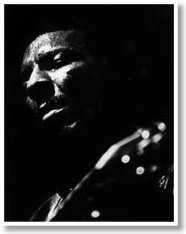 Draped in a long, blue dress shirt of exquisite material, with finely embroidered edges, Havens, with his trademark overgrown beard, sat on a stool, singing at times and then talking to the people as if he were a half-singer-half-spoken word storyteller. “This tour started in January 1969,” he mentioned humorously. “For all of you young guys, my generation was very interesting. We were the best-looking generation.” Probably true, but his generation was also the generation of revolution in the modern sphere; Havens is a symbol of this. And you’re never too old to tell jokes, as Havens admitted: “I’ve been here a long time…I hear aliens now.”
Draped in a long, blue dress shirt of exquisite material, with finely embroidered edges, Havens, with his trademark overgrown beard, sat on a stool, singing at times and then talking to the people as if he were a half-singer-half-spoken word storyteller. “This tour started in January 1969,” he mentioned humorously. “For all of you young guys, my generation was very interesting. We were the best-looking generation.” Probably true, but his generation was also the generation of revolution in the modern sphere; Havens is a symbol of this. And you’re never too old to tell jokes, as Havens admitted: “I’ve been here a long time…I hear aliens now.”
The mixed bag of songs included renditions and originals, ranging from the Gary Wright classic “Love Is Alive,” the blues of Dylan’s enduring “Maggie’s Farm,” his remarkable take on the Beatles’ “Here Comes The Sun” and his signature tune “Freedom” based on the timeless spiritual “(Sometimes I Feel Like A) Motherless Child.” The latter was illustrated by jovial handclaps from the people, and in the last segment of the song, Havens actually performed a guitar solo on his feet that deserved its standing ovation even before he finished.
There’s no doubt that Havens is an exceptional guitarist, his fingers radiating percussive sounds, and that his smoke-tinged, gruff vocalizations matched the constant toe-tapping of his right foot. While he hardly looked at the audience when he sang, the emotion displayed on his face seemed to transport him back into the 1960s, inspiring the idea that music is ageless. And even though his deep voice mumbled at times when he spoke, you were still able to get the crux of his message if you followed closely. Even if folk music isn’t your interest, Havens’ wonderful guitar skills and careful selection of songs – balancing them with upbeat folk and balladry – all made the performance memorable.
by Jeff Boyce
Casbeer’s At the Church
San Antonio, Texas
The admixture of acoustic folk music, a church building and alcohol might be unusual to the average concert attendee nowadays, but it does not automatically mean the setting is a recipe for disaster. Reach back into the grooves of the 1960s and you will see that challenging norms was the order of the day, whether it was “Jesus freaks” fusing rock with gospel music, soul performers merging the fervor of gospel with radically militant themes, experimental psychedelics or aural musical revolutionaries such as the Beatles, James Brown and Bob Dylan. But what spoke to the commoner the most was folk music, the layman’s language, a musical genre that saw a great revival in the late ‘50s and early ‘60s and itself challenged traditional views of yesteryear. One such folk artist from this era – the veteran Richie Havens – is still able to draw from his roots in this period and relay them to nostalgic and young college-level audience members at a former church-now-turned-concert venue.

The mixed bag of songs included renditions and originals, ranging from the Gary Wright classic “Love Is Alive,” the blues of Dylan’s enduring “Maggie’s Farm,” his remarkable take on the Beatles’ “Here Comes The Sun” and his signature tune “Freedom” based on the timeless spiritual “(Sometimes I Feel Like A) Motherless Child.” The latter was illustrated by jovial handclaps from the people, and in the last segment of the song, Havens actually performed a guitar solo on his feet that deserved its standing ovation even before he finished.
There’s no doubt that Havens is an exceptional guitarist, his fingers radiating percussive sounds, and that his smoke-tinged, gruff vocalizations matched the constant toe-tapping of his right foot. While he hardly looked at the audience when he sang, the emotion displayed on his face seemed to transport him back into the 1960s, inspiring the idea that music is ageless. And even though his deep voice mumbled at times when he spoke, you were still able to get the crux of his message if you followed closely. Even if folk music isn’t your interest, Havens’ wonderful guitar skills and careful selection of songs – balancing them with upbeat folk and balladry – all made the performance memorable.
by Jeff Boyce
Joseph Arthur
Joseph Arthur
Cactus Café
Austin, Texas
One-man band Joseph Arthur’s two-night stint at the Cactus Café in Austin, Texas, began with a hitch before the concert started – his amp blew up. The audience was not let into the quaint venue until another amp was acquired. But once inside, the setting of the intimate performance was revealed: tucked into a corner, a small stage adorned with red drapery and a blank, tall canvas was barely enough room for Arthur and his gang of guitars. A sit-down, two-set show, the singer-songwriter and visual artist was keen on combining the aesthetics of sound and vision.
Running late, the first set was markedly restrained. Witness the skeletal “A Smile That Explodes.” Normally a duet, the defeated, dirge-like song isolated Arthur’s gravelly tenor with his acoustic strumming as his only companion. The song withered with the last lyric: “I write one more letter I won’t send except for across the floor.” The sound of ice rattling in the audience’s glasses could be heard.
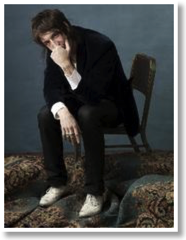 The audience bobbed to the melancholic thump of Arthur’s anxiety-ridden songs. A folk-rock singer-songwriter at heart, his songs flirted with electronic flourishes and eclectic experimentation. The unreleased “Watch Our Shadows Run,” driven by a simple melody and militaristic march, chronicles a relationship marred by betrayal. His falsetto rings nihilistic – “Here comes the sun, watch our shadows run. It’s a war no one ever won” – before launching into a guitar solo that culminates into a dogpile of dissonance and noise rising and falling. Many of Arthur’s songs vamp as different elements are looped and delayed into destruction. Sometimes, he harmonizes with himself as vocals are piled.
The audience bobbed to the melancholic thump of Arthur’s anxiety-ridden songs. A folk-rock singer-songwriter at heart, his songs flirted with electronic flourishes and eclectic experimentation. The unreleased “Watch Our Shadows Run,” driven by a simple melody and militaristic march, chronicles a relationship marred by betrayal. His falsetto rings nihilistic – “Here comes the sun, watch our shadows run. It’s a war no one ever won” – before launching into a guitar solo that culminates into a dogpile of dissonance and noise rising and falling. Many of Arthur’s songs vamp as different elements are looped and delayed into destruction. Sometimes, he harmonizes with himself as vocals are piled.
As the first set wound down, a crowd favorite – “Birthday Card” – was dedicated to a woman in the audience. It brought her to tears. On the last song of the first set, Arthur painted on a blank canvas while singing into the mic. An amorphous, fractured face eventually appeared in front of a monochromatic background. In the span of one, looped song, he depicted the face of a man on the edge of a breakdown, trying to heal.
After a 15-minute intermission, Arthur began his second set as a looser bard. If the first set found him hushed with little stage banter, the next set proved more energetic. The harmonica-laden “I Donated Myself to the Mexican Army” was evidence enough with his voice soaring above a wistful lull. When Arthur stop-started a song, mentioning that his harmonica was out of tune, someone in the audience asked, “What would Bob Dylan do?” Arthur’s response: “Keep playing.”
by Joshua Barajas
Cactus Café
Austin, Texas
One-man band Joseph Arthur’s two-night stint at the Cactus Café in Austin, Texas, began with a hitch before the concert started – his amp blew up. The audience was not let into the quaint venue until another amp was acquired. But once inside, the setting of the intimate performance was revealed: tucked into a corner, a small stage adorned with red drapery and a blank, tall canvas was barely enough room for Arthur and his gang of guitars. A sit-down, two-set show, the singer-songwriter and visual artist was keen on combining the aesthetics of sound and vision.
Running late, the first set was markedly restrained. Witness the skeletal “A Smile That Explodes.” Normally a duet, the defeated, dirge-like song isolated Arthur’s gravelly tenor with his acoustic strumming as his only companion. The song withered with the last lyric: “I write one more letter I won’t send except for across the floor.” The sound of ice rattling in the audience’s glasses could be heard.

As the first set wound down, a crowd favorite – “Birthday Card” – was dedicated to a woman in the audience. It brought her to tears. On the last song of the first set, Arthur painted on a blank canvas while singing into the mic. An amorphous, fractured face eventually appeared in front of a monochromatic background. In the span of one, looped song, he depicted the face of a man on the edge of a breakdown, trying to heal.
After a 15-minute intermission, Arthur began his second set as a looser bard. If the first set found him hushed with little stage banter, the next set proved more energetic. The harmonica-laden “I Donated Myself to the Mexican Army” was evidence enough with his voice soaring above a wistful lull. When Arthur stop-started a song, mentioning that his harmonica was out of tune, someone in the audience asked, “What would Bob Dylan do?” Arthur’s response: “Keep playing.”
by Joshua Barajas
Four Tet & Nathan Fake
Four Tet & Nathan Fake
Mohawk
Austin, Texas
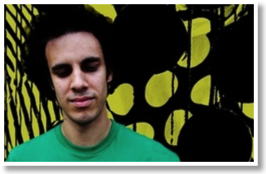 Electronic music is one of the most misunderstood languages of music. It is a diverse spectrum, ranging from some of the experimental classical musicians of the 20th century and krautrock to the synth-pop of the ‘80s and today’s drum & bass and trance arenas. It is also a springboard for some true creative talent by the likes of Karlheinz Stockhausen, Yellow Magic Orchestra, Afrika Bambaataa, Terry Riley, Jean-Michel Jarre, Tangerine Dream, Depeche Mode, Aphex Twin and Daft Punk. In this category are Four Tet and Nathan Fake, experimentalists with complex and layered sounds that may sound deceptively simple to the average ear but are far from that. Their praised electronic art has earned them credibility, and they have been able to forge a small fan base in the indie and alternative rock communities.
Electronic music is one of the most misunderstood languages of music. It is a diverse spectrum, ranging from some of the experimental classical musicians of the 20th century and krautrock to the synth-pop of the ‘80s and today’s drum & bass and trance arenas. It is also a springboard for some true creative talent by the likes of Karlheinz Stockhausen, Yellow Magic Orchestra, Afrika Bambaataa, Terry Riley, Jean-Michel Jarre, Tangerine Dream, Depeche Mode, Aphex Twin and Daft Punk. In this category are Four Tet and Nathan Fake, experimentalists with complex and layered sounds that may sound deceptively simple to the average ear but are far from that. Their praised electronic art has earned them credibility, and they have been able to forge a small fan base in the indie and alternative rock communities.
Nathan Fake started the night with hypnotically atmospheric instrumental fare that at times seemed sci-fi in nature, but it was never of the campy variety because of his talented beat-making status, stringing samples with loops and whatnot to create an aurally invigorating excursion -- all in the space of a live setting. He wore his trademark plain shirt with a big dot in the center, which seemed to give the impression that everything was simple on the surface, but deep down it was actually the opposite -- deep down representing the talent he possesses. The audience packed the floor, with some heads moving to the synth wizardry unfolding before them; it’s a tell-tale sign of what electronic music encapsulates: there is the physical movement and then there is the cerebral appeal. And some skirt that fine line without alienating a core fan base, like Nathan. As a result, he has been able to have some of his works featured in mainstream media appearances while still pleasing his intended audience.
The more famous act, Four Tet, the alias for Kieran Hebden, incorporated mechanistic and organic sounds - all generated live with great precision and tunefulness in the shape of experimentalism. If listeners paid close attention, they could hear jazz pieces one minute and then the next minute folk elements all in an electronic background. Again, the music may seem as simple as the blue shirt he donned, but such detail to his music has gotten him collaborations with artists such as the legendary Radiohead, Manic Street Preachers, Beth Orton, Super Furry Animals and even metal monsters Black Sabbath.
The average audience member might be pleased with the different collages of electronic sounds emanating from big speakers (which explains both acts’ appeals to even a cult indie-alternative rock following), but DJs, producers, remixers and those in the know would be thrilled with Four Tet’s and Nathan Fake’s thoroughly engrossing musical adventures. They defy the stigma of electronic music as mindless, mechanistic noise or cheesy, made-for-the-quick-buck grooves that anyone can make from the comfort of their own home. Taking bits and pieces and transforming them into a complete musical experience is no easy feat, and both acts were able to demonstrate their talent to audiences who can appreciate the more cerebral portion of electronic music.
by Jeff Boyce
Mohawk
Austin, Texas

Nathan Fake started the night with hypnotically atmospheric instrumental fare that at times seemed sci-fi in nature, but it was never of the campy variety because of his talented beat-making status, stringing samples with loops and whatnot to create an aurally invigorating excursion -- all in the space of a live setting. He wore his trademark plain shirt with a big dot in the center, which seemed to give the impression that everything was simple on the surface, but deep down it was actually the opposite -- deep down representing the talent he possesses. The audience packed the floor, with some heads moving to the synth wizardry unfolding before them; it’s a tell-tale sign of what electronic music encapsulates: there is the physical movement and then there is the cerebral appeal. And some skirt that fine line without alienating a core fan base, like Nathan. As a result, he has been able to have some of his works featured in mainstream media appearances while still pleasing his intended audience.
The more famous act, Four Tet, the alias for Kieran Hebden, incorporated mechanistic and organic sounds - all generated live with great precision and tunefulness in the shape of experimentalism. If listeners paid close attention, they could hear jazz pieces one minute and then the next minute folk elements all in an electronic background. Again, the music may seem as simple as the blue shirt he donned, but such detail to his music has gotten him collaborations with artists such as the legendary Radiohead, Manic Street Preachers, Beth Orton, Super Furry Animals and even metal monsters Black Sabbath.
The average audience member might be pleased with the different collages of electronic sounds emanating from big speakers (which explains both acts’ appeals to even a cult indie-alternative rock following), but DJs, producers, remixers and those in the know would be thrilled with Four Tet’s and Nathan Fake’s thoroughly engrossing musical adventures. They defy the stigma of electronic music as mindless, mechanistic noise or cheesy, made-for-the-quick-buck grooves that anyone can make from the comfort of their own home. Taking bits and pieces and transforming them into a complete musical experience is no easy feat, and both acts were able to demonstrate their talent to audiences who can appreciate the more cerebral portion of electronic music.
by Jeff Boyce
Follow That Bird
Follow That Bird
Halley’s
Denton, Texas
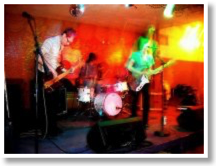 A week before the chaotic sprawling of Austin’s South by Southwest music festival, and more than 200 miles to the north, Dentonites were staging their own music festival, North by 35. The festival is named for the highway that connects Dallas to Denton, and passes through a stretch of farms that leads to the prairie town. Follow That Bird!, a young, spirited garage-rock band, made the trek to from Austin to Denton and made a lasting impression with a 30-minute set on the last night of the festival. As a prelude to their seven appearances at SXSW, the trio’s poised to earn fans beyond Austin’s music scene.
A week before the chaotic sprawling of Austin’s South by Southwest music festival, and more than 200 miles to the north, Dentonites were staging their own music festival, North by 35. The festival is named for the highway that connects Dallas to Denton, and passes through a stretch of farms that leads to the prairie town. Follow That Bird!, a young, spirited garage-rock band, made the trek to from Austin to Denton and made a lasting impression with a 30-minute set on the last night of the festival. As a prelude to their seven appearances at SXSW, the trio’s poised to earn fans beyond Austin’s music scene.
Playing to an exhausted crowd at Hailey’s, the band’s frenetic energy did not wane. While Lauren Green’s loose belt and propulsive guitar made her an adept frontwoman, Tiffanie Lanmon banged the drums with aplomb creating a rhythm section with bassist Mitchell Tellstrom that supported measured, wiry tunes that excited the attentive crowd. Midway through their set, they played a requested song, “Houses Under The Sea.” A jangly, start-stop affair, Green mewled as the song abruptly shifted gears to a slower, jaunty intermission before racing, again, to the end.
Earning the lead spot on Matador Records’ Casual Victim Pile, a compilation of Austin’s music scene, “The Ghosts That Wake You” began with an echoing guitar that culminated in a blistering collision of bravura riffs and syncopated drums. Besides an EP and three-song 10-inch from last year, Follow That Bird!’s itching for a full-length CD. While a potential offer has surfaced, since their appearance on Pile, the band hopes that their blitz of shows during SXSW will yield more possibilities. If their fiery performance in Denton was any indication, Follow That Bird! cannot help but stand out during the March SXSW event.
by Joshua Barajas
Halley’s
Denton, Texas

Playing to an exhausted crowd at Hailey’s, the band’s frenetic energy did not wane. While Lauren Green’s loose belt and propulsive guitar made her an adept frontwoman, Tiffanie Lanmon banged the drums with aplomb creating a rhythm section with bassist Mitchell Tellstrom that supported measured, wiry tunes that excited the attentive crowd. Midway through their set, they played a requested song, “Houses Under The Sea.” A jangly, start-stop affair, Green mewled as the song abruptly shifted gears to a slower, jaunty intermission before racing, again, to the end.
Earning the lead spot on Matador Records’ Casual Victim Pile, a compilation of Austin’s music scene, “The Ghosts That Wake You” began with an echoing guitar that culminated in a blistering collision of bravura riffs and syncopated drums. Besides an EP and three-song 10-inch from last year, Follow That Bird!’s itching for a full-length CD. While a potential offer has surfaced, since their appearance on Pile, the band hopes that their blitz of shows during SXSW will yield more possibilities. If their fiery performance in Denton was any indication, Follow That Bird! cannot help but stand out during the March SXSW event.
by Joshua Barajas


